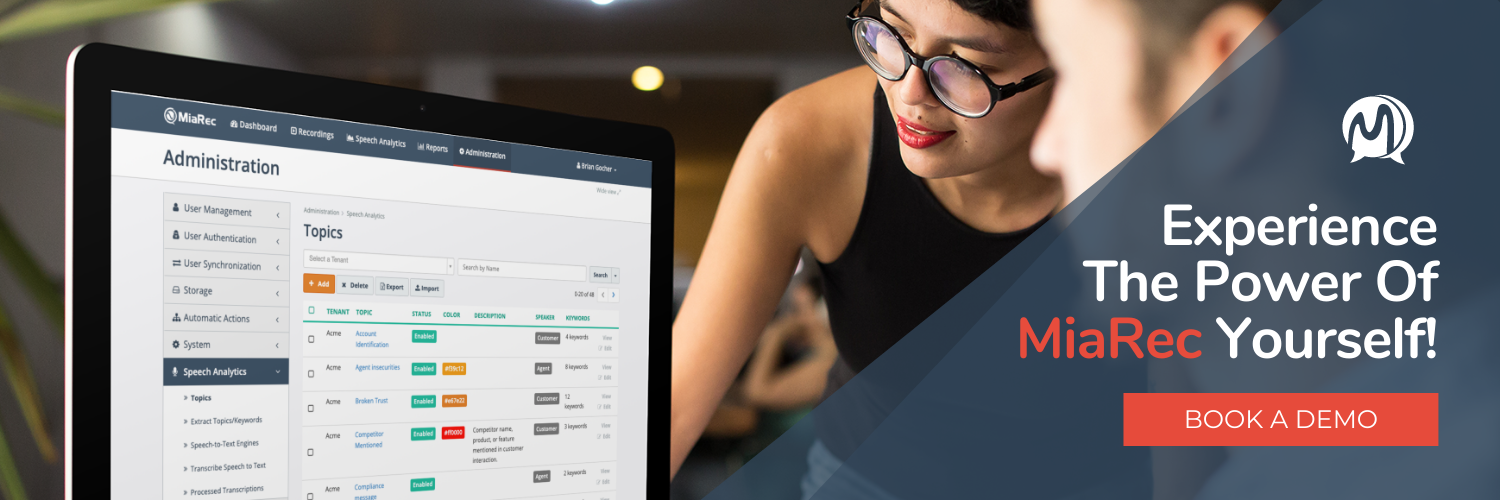How AI Can Help Health & Life Insurance Contact Centers Streamline Data Capture & Entry Workflows
Are your agents struggling to correctly and quickly capture all the information required? Are you constantly trying to find ways to lessen the burden on your agents while empowering them to provide better service quality while increasing contact center efficiency?
Here at MiaRec, we have helped hundreds of contact centers, including medium-size and large health and life insurance companies, streamline and accelerate their contact center workflows. One way, we do this is to enable agents to use Generative AI to extract all necessary key facts from a call recording automatically in the required format and then push it into the CRM. This significantly streamlines the data capture and entry process.
This article explains what types of key facts health and life insurance contact centers usually extract from conversations and how this information is pulled into the CRM. By the end of the article, you will have a better understanding of what is possible with AI but also how easy it is to write your own prompts to get exactly the data in the format you need it.
Extract Key Facts From Customer Interactions In Your Health & Life Insurance Contact Center
One of the key tasks of any agent working in a health or life insurance contact center is to accurately and quickly capture specific data points. This information helps the agent identify the correct coverage plan or provide the best service to an existing customer and serves as the basis for risk calculations, insurance coverage plans, and much more. Until now, agents have had to ask all the right questions, listen to the answers while navigating a conversation with the customer, and enter the information into a CRM system correctly.
Contact Center AI is an absolute game-changer for that. First, it will transcribe the call recording and extract crucial data points. For health insurance, these key facts could include the following:
- Date of Birth: To determine eligibility and plan rates for all family members.
- Zip Code: To identify available health plans based on geographic location.
- Total Yearly Gross Income: To determine eligibility for government subsidies.
- Household Size: Crucial for calculating subsidy amounts and selecting appropriate plans.
- Health Conditions: Information about current health issues to tailor plan recommendations.
- Medication Details: Types of medications taken by the customer for accurate plan matching.
- Frequency of Doctor Visits: To recommend plans based on healthcare utilization.
- Specialist Needs: Identifying any specialist care requirements for plan customization.
- Lifestyle Factors: Information about habits like smoking, alcohol use, or high-risk activities that can impact insurance rates.
- Insurance Carrier Name and Plan Level: For detailed plan options, choose Bronze, Silver, Gold, or Platinum.
- Monthly Premiums, Deductibles, and Max Out-of-Pocket Costs: Financial details of plans for customer decision-making.
- Effective Date of Plans: When the coverage starts.
- Qualifying Life Events: For enrollment outside the standard period, such as marriage or job loss.
A lot of the points will also have to be extracted and captured in life insurance contact centers. In addition, agents might ask for:
- Beneficiary Information: Names and relationships of the individuals designated to receive the policy benefits.
- Health History: Detailed personal and family medical history to assess risk and determine premiums.
- Employment and Income Details: To gauge the appropriate coverage amount based on the policyholder's financial situation.
- Coverage Amount Desired: The desired sum insured which affects premium calculations and policy recommendations.
- Policy Duration: Length of the policy term or interest in whole life versus term life insurance.
- Existing Policies: Details of any current life insurance coverage to avoid over-insurance or identify gaps.
- Financial Goals and Needs: Information to help tailor the life insurance to support the policyholder's long-term financial plans, such as estate planning or securing the family's future.
This list is, of course, just giving a few examples and is by no means exhaustive. You can customize this list to the key facts that your organization needs and add whatever else you need.
Crafting Precise Prompts For Accurate Data Extraction
In theory, Generative AI can extract all kinds of information in whatever format you wish. This includes brief unstructured summaries, bullet-pointed chronological recaps, or, in this case, the exact information you need.
However, at the moment, most Conversation Intelligence or Contact Center AI solutions will only provide you with pre-canned prompts, making it hard to impossible to extract the exact information you need.
Use The MiaRec AI Prompt Designer To Create & Refine Your Prompts
Here at MiaRec, we believe that you need 100% flexibility to create and refine your prompts to get the most accurate information. With the new MiaRec AI Prompt Designer, you can now fine-tune your Generative AI prompts to exactly what you need to extract all the information required in the format you need them in. You can do this safely in a testing environment on actual calls and when you are happy with the quality of response, you can deploy it into your live environment.
Sounds complicated? It is not. You do not need a data science degree or hire a prompt engineer. You write the prompts using natural language. However, there are a few simple best practices to consider.
Writing prompts to extract key facts from a customer conversation slightly differs from writing a prompt asking the AI to summarize the conversation. We need to be precise because we want to pull out exact data points. Here are some tips:
Define The Data Format You Need
Tell the AI in your prompt which exact format you need the data or fact to be presented in, such as MM/DD/YYYY or DD.MM.YY for a date. By providing clear instructions on the data format, you empower the AI to extract key facts with precision and efficiency.
Give Examples To Follow
While Contact Center AI is very advanced, it often helps to provide an example for it to follow. For example, you might want to extract a patient ID. You provide an example in your prompt: The patient ID consists of CC and an eight-number string, for example, CC12345678.
Provide A List Of Options To Choose From
Sometimes, you need to capture an option from an approved list, such as the level of preferred healthcare plan (Bronze, Silver, Gold, or Platinum) or the insurance provider's name. In this case, it is wise to provide a list of acceptable options for the AI to choose from and to make it very clear that this data point must be selected from this list and nothing else.
Use Generative AI To Accelerate CRM Data Entry
Manual data entry is tedious and takes time, but it can also be laden with errors and is often prone to mishandling. You can use Generative AI to assist your agents with data entry to save time and reduce errors. Some solutions allow integration with CRM systems, and everyone has a slightly different approach, but to illustrate the point, I will walk you through how you can set up this process with MiaRec.
With MiaRec, you can pull almost all the metadata from MiaRec to your CRM. including call information (call duration, call direction, etc), sentiment scores, call topics, and AI insights. The only metadata you cannot pull into a CRM are evaluations (the actual scorecards) and advanced reports. However, that functionality will be added in the future.
In other words, every key fact you extracted from your conversations using AI (as described above) can be pulled into a CRM. Technically, this is achieved by pushing the extracted data into a custom field in MiaRec and then mapped into your CRM database properties via API integration.
Conclusion
In conclusion, AI revolutionizes how health and life insurance contact center agents capture and enter data during customer conversations. Contact center agents are often overwhelmed trying to balance the need to provide outstanding service and to capture and enter key data points accurately and quickly with the need to be efficient and fast. AI can significantly streamline and accelerate those workflows, reducing the burden on agents and ensuring accuracy and efficiency.
MiaRec is helping hundreds of contact centers around the world solve this problem. While our solution isn't the right fit for every health and life insurance company, we hope you find this information helpful in making the right choice for your organization.
You May Also Like
These Related Stories

How MiaRec Helps BPOs Overcome 5 Common Challenges

What's New at MiaRec in 2024/ Interview for Call Centre Helper TV


